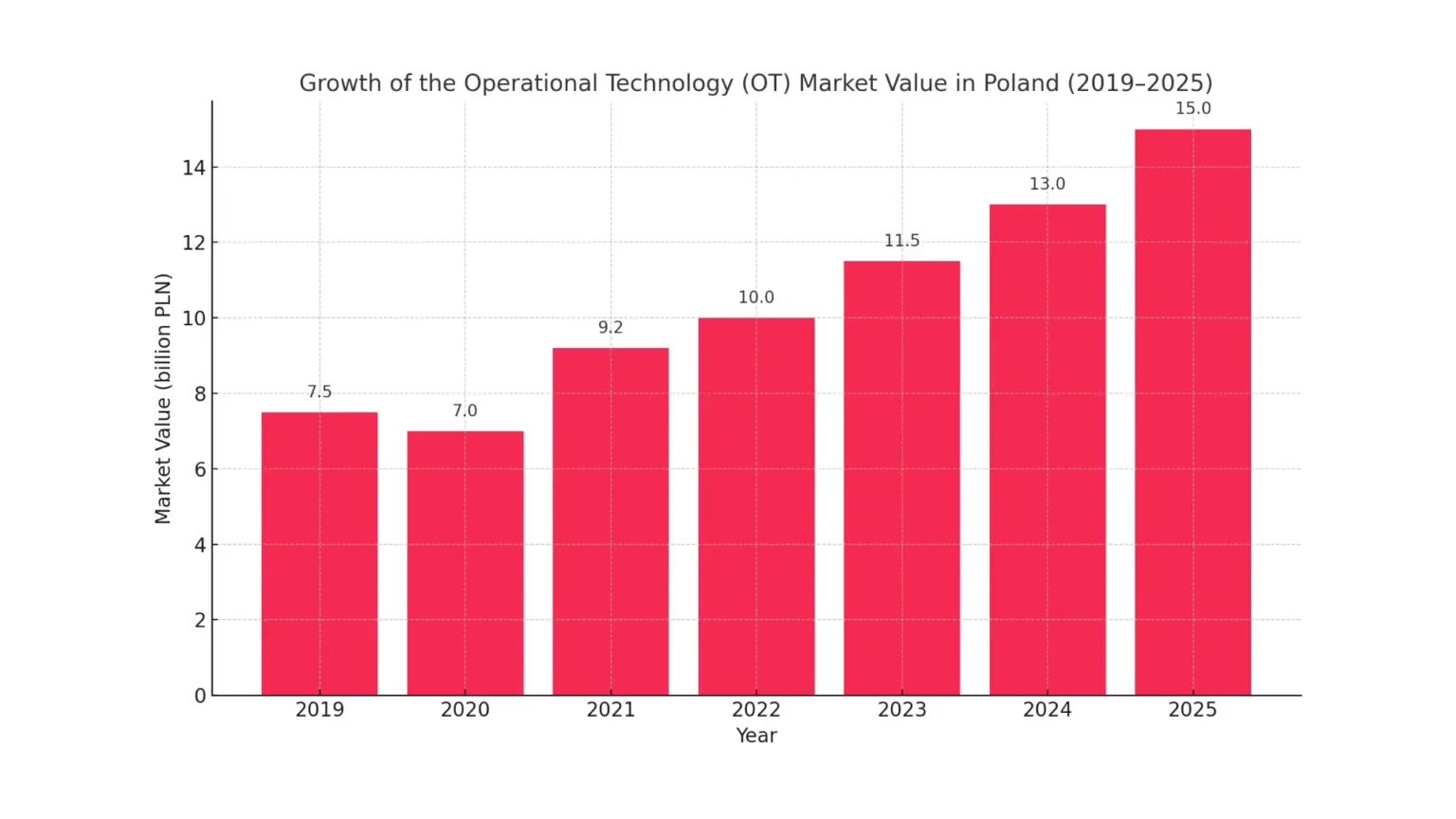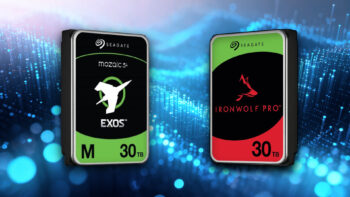Operational technology (OT) – i.e. industrial control, automation and critical infrastructure systems – has become a pillar of digital transformation in industry. The convergence of OT with classic IT systems is gaining momentum with the development of Industry 4.0. As a result, Polish companies are increasingly investing in automation, Industrial IoT (IIoT) and OT cyber security to increase the efficiency, competitiveness and operational resilience of their plants.
Value of the OT market in Poland (2019-2024)
The Polish OT market has been growing rapidly in recent years, almost doubling in value from 2019 to 2024. It is estimated that in 2019, the value of the domestic OT market was around PLN 6-7 billion, while in 2024 it is already reaching over PLN 13 billion, despite a periodic slowdown during the pandemic. Such significant growth – averaging around 15% per year – reflects the increasing demand for industrial automation solutions, SCADA/PLC systems, IT/OT integration and security services in industrial environments. For example, the Industrial Internet of Things (IIoT) segment in Poland reached a value of around PLN 10 billion in 2023, growing by 20% year-on-year. The domestic industrial automation and robotics industry has also grown strongly, with more than 210 companies already operating in it, generating a total of more than PLN 9 billion in revenue annually. The growth of the market is driven by the need to increase productivity and reduce costs: companies are investing in OT to increase productivity, precision and process safety, reduce human error and cope with skills shortages.
Market value forecasts for 2025 and 2030
The outlook for the OT market in Poland remains very optimistic. Maintaining a double-digit growth rate suggests that this market will exceed PLN 15-16 billion in 2025, and could reach PLN 30 billion by 2030 (i.e. another doubling of scale). These forecasts correspond with global trends – the global IT/OT convergence market (comprising OT and IT software and OT hardware) is valued at US$720bn in 2023, and IoT Analytics predicts it will grow by 8.5% per year to over US$1 trillion in 2027. The OT cyber security segment, on the other hand, is expected to grow globally at up to 15-25% per year, reaching USD 80-120 billion in 2030. Poland – as an economy catching up in terms of automation – may maintain a double-digit OT growth rate in the current decade as well. It is worth noting that these forecasts depend on a number of factors, including the industrial conjuncture, the availability of engineering staff and the pace of regulatory implementation (e.g. the NIS2 directive on critical infrastructure). Nevertheless, the trend is clear: operational technologies will become an increasingly important part of the ICT market in Poland, and investments in this area will accelerate as the concept of Industry 4.0 matures.
Key technological trends in OT
The development of the OT market is being driven by technological changes that are transforming traditional factories into modern, digital factories. Key trends include:
- Automation and robotisation of production: Polish manufacturing companies are intensively implementing automation, industrial robots and control systems to compete. Automation improves efficiency and quality – “companies looking for ways to minimise human error and increase productivity are implementing solutions such as robotics, AI or IoT-based systems”. Despite the progress, the level of robotisation in Poland is still low compared to the world (only 52 robots per 10,000 industrial workers vs. 397 in Germany), which means there is huge potential for further growth. The automation trend will therefore maintain a high momentum for a long time, especially as rising labour costs and staff shortages force companies to invest in robots and automated production lines.
- Industrial Internet of Things (IIoT): More and more equipment and machines in factories are being equipped with sensors and communication modules, creating an IIoT network. Real-time collection and analysis of production data enables process optimisation, predictive maintenance and improved asset management. IIoT is the fastest-growing segment of Industry 4.0 – it already accounts for around 20% of the global Industry 4.0 market. In Poland, spending on IoT is growing by double digits (despite a slowdown to 14% growth in 2024) and increasing IIoT applications can be seen in the energy sector (smart grid, meters), food industry or logistics, among others. According to Allied Market Research, the global IIoT market could reach an astronomical US$1.5 trillion by 2030, showing the scale of the trend.
- Artificial intelligence and data analytics: AI and machine learning are increasingly boldly entering OT environments. AI algorithms analyse sensor data streams so that factories can realise advanced analytics, automatic parameter adjustments and predictive maintenance. Integrating AI/ML with automation systems provides new opportunities for diagnostics, predictive maintenance and decision support – for example, learning models predict machine failures, optimise energy consumption or even control robots adaptively. As a result, factories are becoming smarter and more autonomous, fitting in with the Smart Factory concept. This trend is set to grow – suffice it to mention that the global AI market in the area of security (including OT) is expected to grow from USD 15 billion in 2021 to USD 135 billion in 2030. Poland is not lagging behind – indigenous companies are experimenting with the vision of ‘digital twins’ of production lines and using AI to optimise processes.
- Integration of IT/OT environments: The disappearance of the separation between IT and OT systems is another megatrend. Traditionally, operational systems (e.g. production control) were separated from IT, but now – in the age of fast information needs – they are increasingly being connected. “Connecting OT systems to IT networks increases their efficiency on the one hand, but on the other increases the risk of cyber attacks. IT/OT convergence enables the integration of data from the shop floor with business systems (ERP, cloud), providing holistic insights into company operations and new opportunities for optimisation. According to the IoT Analytics report, the integration of these worlds is already a strategic necessity for companies pursuing digital transformation. Globally, the cumulative market for IT/OT solutions is huge, as highlighted by the calculations – more than USD 720 billion in 2023. In Poland, integration is progressing for the time being in selected sectors (e.g. smart grid in energy, where SCADA systems are connected to data centres – energy is the main driver of SCADA demand). However, it remains a challenge to combine the different working cultures of IT teams vs. OT engineers and to upgrade older industrial installations, which often operate in isolation from the grid. Integration therefore requires specialised expertise and a well thought-out strategy, but offers tangible benefits – consistent infrastructure management and real-time access to operational data. For integrators and technology providers, it is also an opportunity to expand their offerings – IT solution manufacturers are intensively adapting their systems to the specifics of OT.
- OT cyber security: The increasing digitalisation of industry makes protecting OT systems from cyber attacks a priority. Production environments have different characteristics than classic IT – here, a failure due to an attack can bring a production line to a halt or put people’s safety at risk. Unfortunately, attacks are increasing exponentially: in 2022, the number of cyber incidents against OT devices increased from 20 million to 120 million, and in Poland, ransomware incidents targeting industry have increased sixfold recently. Key trends in OT security are the Zero Trust model (already 58% of companies are implementing Zero Trust in OT in 2024, up from 21% in 2022) and network segmentation (locking critical devices into micro-zones to make it harder for attacks to spread). Dedicated ICS/OT monitoring solutions are emerging, detecting anomalies in industrial networks without disrupting the process. Unfortunately, many plants still rely on outdated control systems with known vulnerabilities and lack of updates. Lack of full visibility of OT assets and the use of proprietary, unencrypted communication protocols are further problems. In response, companies are increasing investment in security: according to estimates, the Polish market for cyber security solutions (including OT) is already approx. PLN 2.5-3 billion in 2024. Regulations are also forcing progress – the NIS2 directive in the EU, ISA/IEC 62443 standards or national laws oblige infrastructure operators to implement advanced security measures. All this means that the OT security segment will be one of the fastest-growing areas of the market (by double digits per year), although there is still a shortage of specialists – only 9% of IT/automation professionals focus exclusively on ICS/OT security, which means intensive staff training is needed.
Growth dynamics and main sectors of demand
The average annual growth rate of the Polish OT market between 2019 and 2024 was estimated to be around 15 per cent (CAGR) – a rate higher than that of the overall ICT market. Growth was primarily driven by demand in three vertical sectors: manufacturing, energy and transport and logistics.
- Industry (manufacturing): Has accounted for the largest share of OT spending for years – it is estimated that the manufacturing sector generates around 18-20% of demand for IIoT solutions. It is in factories that most robots and control systems are installed. Poland has a strong automotive, food and chemical industry – all these industries are investing in line automation, IoT sensors and MES/SCADA systems for production supervision. 2021 brought an investment boom (more than 3,300 robots installed, +56% y-o-y), but the following years (2022-2023) brought a temporary slowdown in robotisation (declines in robot deliveries of several percent) due to supply chain disruptions and economic uncertainty. Despite this, the industry will continue to invest in the long term – Polish factories need to automate faster to catch up with the competition, especially as staying in the global market requires automation and robotisation of production. It can be expected that with an improvement in the economy and an influx of funds (e.g. KPO, EU funds for industrial transformation), industry spending on OT will get back on an upward trajectory.
- Energy and utilities: the energy sector is a key driver of demand for OT solutions, especially SCADA systems, industrial networks and critical infrastructure protection. The automation of electricity grids (smart grid) and the modernisation of gas or water infrastructure require advanced OT systems. According to analysts, it is the energy industry that will be the main catalyst for demand for SCADA systems by 2024. – Increasing investments in smart grids and substations translate into the need to monitor thousands of devices in the field. In Poland, the challenges of the energy transition (RES, distributed energy) will further increase the demand for OT – automation systems for managing the grid, energy storage or PV/windmill farms. In addition, the power industry, as critical infrastructure, is investing heavily in OT cyber security – required by NIS regulations and crucial in view of increased cyber attacks on the energy sector in the region.
- Transport and logistics: automation and OT are playing a growing role in transport – from rail and urban traffic control to airport systems to smart warehouses and logistics centres. Transport and logistics are among the fastest growing consumers of IIoT, with a projected increase in spending of up to +26% y/y globally. In Poland, we see this in the modernisation of railways (new train control systems, sensors on tracks), the development of road infrastructure (traffic management systems, ITS) or the automation of warehouses in e-commerce. Logistics companies are deploying IoT sensors for supply chain and vehicle tracking, while ports are investing in OT systems to increase throughput. The digitalisation of supply chains (autonomous warehouses, AGVs, sorting robots) is further driving the demand for OT in logistics. This sector is growing rapidly with the boom in online shopping and the need for efficient distribution of goods.
It is worth noting that, in addition to those mentioned, significant adopters of OT technologies include the food sector (many food production lines are already highly automated), the mining sector (mines are implementing OT systems for safety and control) and the healthcare sector (HVAC and power automation in hospitals, medical IoT devices). Even local governments are investing in urban IoT systems (smart lighting, environmental monitoring), which also falls into the broad area of OT.
Overall, demand for OT in Poland is multi-sectoral, but industry, energy and transport are the cornerstones and will account for the largest share of market growth in the coming years. Each of these sectors is driven by slightly different motivations – industry by productivity and lack of manpower, energy by grid reliability and ecological transformation, transport by efficiency and safety – but the common denominator is a shift towards OT as a solution to strategic challenges.
The future of the OT market – conclusions and recommendations for IT staff
The Polish operational technology market is entering a mature growth phase. As shown, we can expect further dynamic growth until 2030, with OT becoming a permanent item on the investment agenda of many companies. For IT and business executives, this means a number of strategic actions need to be taken:
1. accelerating IT/OT convergence: today’s companies can no longer afford silos – IT systems (e.g. ERP, analytics) must work seamlessly with OT systems in production. Integration of these environments should become part of a company’s digital strategy. A plan should be in place to connect operational data with office systems, enabling new business benefits from analysing production data in a broader context. However, IT managers must remember that IT/OT integration requires trade-offs and specialised expertise – it is worth investing in team training and working with integrators with experience in both areas. Companies that are first to successfully integrate OT with IT will gain the advantage of more efficient operations and faster access to information from the ‘factory floor’.
2 Investment in OT security and resilience: any industrial transformation initiative must go hand in hand with strengthening cyber security. The risk of cyber attacks on operational infrastructure is real and growing – high-profile incidents (such as the ransomware attack on Colonial Pipeline) have demonstrated the consequences for critical infrastructure. Managers should assume that their OT environments will sooner or later become the target of an attack, especially if they are connected to the IT network. It is recommended to implement a Zero Trust model in the OT area – treating every access and device as potentially hostile, network segmentation and strong access control. Visibility of OT assets is also necessary – investment in industrial network monitoring systems that can detect abnormal device behaviour before failure or sabotage occurs. Management should also take care to develop business continuity plans (BCP/DR) that take into account OT technology downtime, as well as meeting regulatory requirements (NIS2 compliance audit, implementation of security standards). OT cyber-security budgets will have to grow – but it is a necessary investment to protect production continuity and the company’s reputation.
3. development of team competencies and a culture of collaboration: The shortage of OT security experts and automation engineers familiar with IT is a barrier that companies already face today. Managers should therefore invest in upgrading the skills of existing staff – e.g. by training automation engineers in cyber security and networking, and IT specialists in the basics of industrial systems. It is worth considering the creation of joint IT/OT teams or at least mechanisms for ongoing collaboration between these departments to break down ‘traditional organisational silos’. Building a culture where IT specialists understand production priorities (continuity, physical security) and OT engineers understand cyber hygiene principles and IT procedures is key. The staffing gap can be partially bridged by working with external managed service providers (MSSPs) that offer, for example, SOC monitoring for OT or industrial network management – but this is no substitute for internal awareness and competence. IT leaders should therefore include dedicated OT-related roles (e.g. OT Security Officer or OT Systems Engineer) in their staffing plans.
4 Long-term planning and innovation: When thinking about the future, executives should already be considering new technology waves on the horizon, such as Industry 5.0, augmented reality (AR) in factories, or the use of digital twin technology for process simulation. Although these concepts are only in their infancy, investments in OT are inherently long-term – the life cycle of industrial systems is often 10-15 years. Therefore, decisions made today (e.g. the choice of automation platform or communication standard) will affect a company’s ability to implement further innovations a decade from now. Managers should design an OT architecture that is open to future expansion, compliant with standards (this will facilitate the integration of new AI/IIoT modules in the future). It is equally important to pilot innovations – such as launching proof-of-concept programmes for AI in maintenance or 5G in the factory – so that the organisation learns new technologies before they become mainstream.
The development of the OT market in Poland is accelerating, reflecting the industry’s transformation towards modern, automated and intelligent operations. Historical data shows strong growth in the value of the market, and forecasts suggest a continuation of this trend in the coming years. Key trends – from automation, to IIoT and AI, to IT/OT integration and cyber-security – are setting the stage for businesses seeking greater efficiency and resilience. For IT managers and technology decision-makers, this means they need to actively engage in OT projects: combining IT and OT competencies, investing in security, training and innovation to take full advantage of the opportunities of Industrial Revolution 4.0 (and in the future 5.0). Polish industry faces a huge opportunity – the right decisions taken today will determine whether indigenous companies will be at the vanguard of the new era of operational technology or remain merely passive recipients of it.












